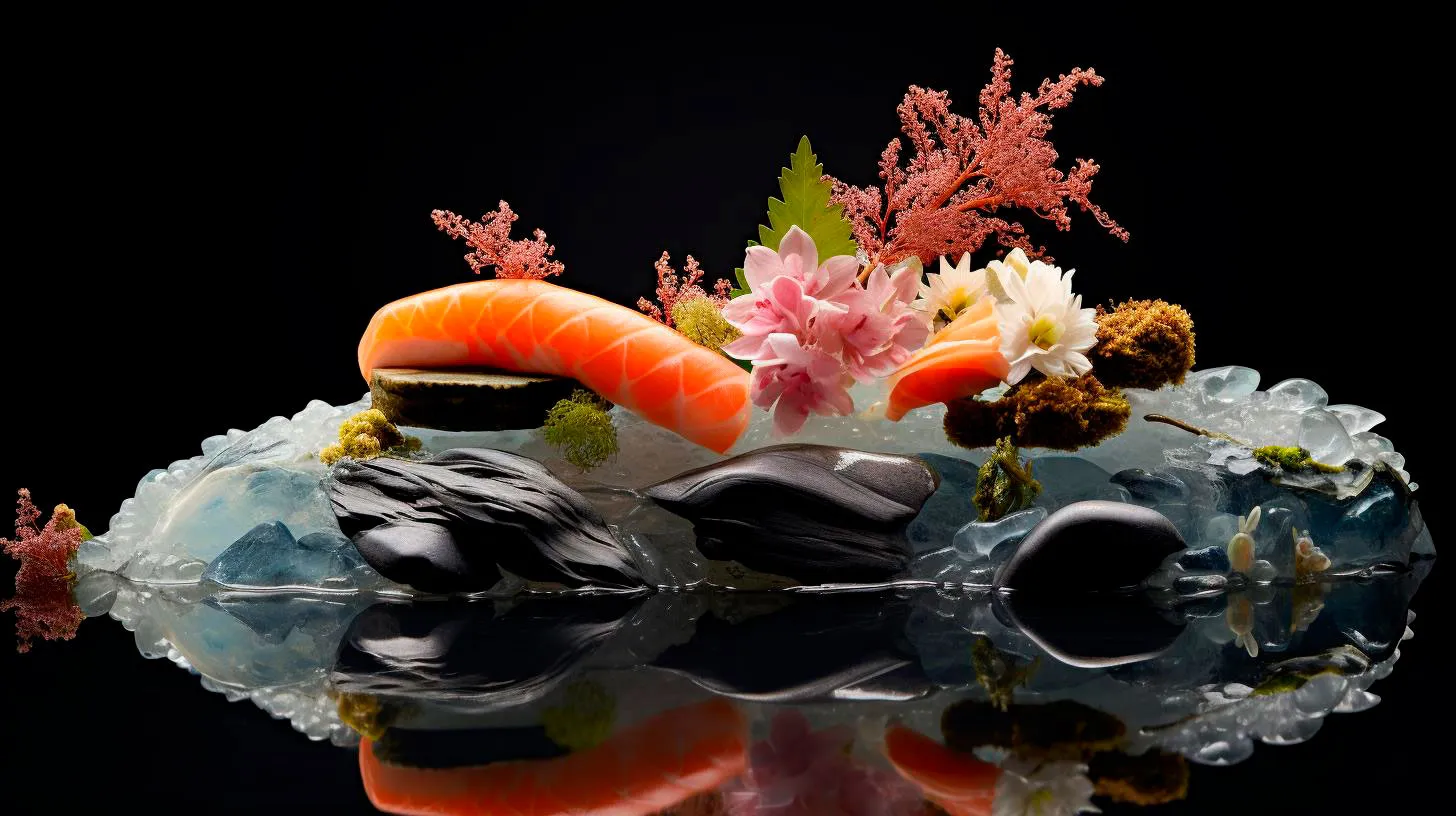Umami Pairing Perfection: How to Create Harmonious Sushi Combinations
While many appreciate sushi for its freshness and craftsmanship, a crucial element in unlocking its full potential lies in the art of umami pairing. Understanding the concept of umami, and how to create harmonious flavor combinations, can elevate your sushi experience to new heights.
The Essence of Umami
Umami, often referred to as the fifth taste sensation, is a Japanese term that translates to “pleasant savory taste.” It was officially recognized in 1985 by the Umami International Symposium held in Hawaii, solidifying its place alongside sweet, sour, salty, and bitter. Umami is commonly found in foods such as tomatoes, mushrooms, cheese, and soy sauce, and it plays a significant role in the culinary world.
What sets umami apart from other tastes is its ability to enhance and deepen flavors, creating a more robust and satisfying palate experience. It acts as a magnifying glass, bringing out the best in other ingredients, making it a powerful tool in creating harmonious umami-rich sushi combinations.
Key Elements for Umami Pairing
To achieve umami pairing perfection, we need to consider a few key elements. These include:
1. Freshness and Quality
The foundation of any excellent sushi experience lies in the freshness and quality of the ingredients. High-quality fish, crisp vegetables, and perfectly cooked rice provide a canvas for umami to shine. Freshness ensures that the natural flavors are at their peak, enhancing the overall taste experience.
2. Balance and Contrast
Creating a harmonious sushi combination relies on striking a balance between different flavors and textures. Combining ingredients with varying tastes, such as sweet and salty or creamy and crunchy, adds depth and complexity to each bite. The interplay of contrasting elements keeps the palate engaged, resulting in an unforgettable dining experience.
3. Complementary Ingredients
Identifying ingredients that naturally complement each other is another crucial aspect of umami pairing. For example, fatty tuna (toro) pairs exceptionally well with creamy avocado and tangy ponzu sauce. Discovering these synergistic combinations enhances the overall umami flavor profile and elevates the enjoyment of each ingredient.
Umami Pairing Examples in Sushi
1. Salmon and Cream Cheese Roll
- Salmon’s delicate flavor and creamy texture complement the richness of cream cheese, resulting in a harmonious combination.
- The umami-rich nori (seaweed) enhances the flavors further, creating a balanced and satisfying roll.
- Add a touch of wasabi and soy sauce for an extra burst of umami.
2. Shrimp Tempura and Spicy Mayo Roll
- The crispy and savory shrimp tempura adds texture and umami to the roll.
- Spicy mayo, made with umami-rich ingredients like mayo, sriracha, and sesame oil, provides a creamy and tangy kick.
- The combination of the two creates a delightful umami explosion in each bite.
3. Uni (Sea Urchin) and Quail Egg Nigiri
- Uni’s distinct briny and sweet flavor combines wonderfully with the richness of a quail egg, creating a luxurious umami experience.
- The creamy and custard-like texture of both ingredients perfectly intertwines, resulting in a melt-in-your-mouth sensation.
- Add a sprinkle of sea salt or a drizzle of soy sauce to heighten the umami flavors even more.
Key Takeaways
Creating harmonious and umami-rich sushi combinations requires attention to detail and understanding the flavor profiles of different ingredients. Here are the key takeaways to remember:
- Umami enhances and deepens flavors, creating a more robust and satisfying palate experience.
- Balance and contrast between flavors and textures are vital in achieving a harmonious pairing.
- Identify complementary ingredients that naturally enhance each other’s umami profiles.
- Experiment with traditional and fusion sushi rolls to discover new taste sensations.
- Freshness and quality of ingredients are crucial in unlocking the full potential of umami pairing.
By mastering the art of umami pairing, you can create sushi combinations that delight the senses and take your dining experience to another level. So next time you indulge in sushi, embrace the power of umami and let your taste buds embark on a journey of flavor perfection.
Beyond Soy Sauce: Unveiling New Umami-Infused Sushi Accompaniments
In this article, we will take a deep dive into the world of umami-infused sushi accompaniments, discussing their origins, key ingredients, and how they can elevate your sushi game to a whole new level.
The Umami Craze
Umami, often referred to as the “fifth taste,” is a Japanese word used to describe a savory and rich flavor. It is known for adding depth and complexity to various dishes, including sushi. Traditionally, soy sauce was the primary umami ingredient used to enhance the flavor of sushi. However, food scientists and culinary experts have been experimenting with different umami-rich ingredients to create unique and flavorful accompaniments.
Let’s explore some of the remarkable umami-infused sushi accompaniments that are redefining the sushi experience:
1. Miso-based Dipping Sauces
Miso, a fermented soybean paste, is renowned for its umami-packed profile. Chefs have been harnessing the power of miso to create mouthwatering dipping sauces. These sauces can vary in flavors, ranging from sweet miso with a hint of citrus to bold miso with spicy notes. Dip your sushi into these delightful sauces, and you’ll be transported to umami heaven.
Key features:
- Umami-rich miso base
- Versatile flavor profiles
- Complements a variety of sushi rolls
2. Yuzu Ponzu
Yuzu, a Japanese citrus fruit, has gained popularity as an ingredient in sushi accompaniments. Yuzu ponzu, a tangy and citrusy sauce, combines the umami flavors of soy sauce and the refreshing notes of yuzu. This zesty sauce adds a burst of flavor to your sushi, enhancing each bite with a delightful balance of sweetness and acidity.
Key features:
- Combines umami and citrusy flavors
- Delicious balance of sweetness and acidity
- Complements seafood-based sushi rolls
3. Furikake Seasoning
Furikake is a Japanese seasoning blend that typically includes sesame seeds, dried seaweed, dried fish flakes, and other flavorful ingredients. This umami-rich seasoning can be sprinkled over sushi rolls, imparting a delightful crunch and an explosion of savory flavors. From spicy furikake to wasabi-flavored furikake, there are numerous options to add an interesting twist to your sushi experience.
Key features:
- Enhances sushi with a crunchy texture
- Full of umami flavors
- Creates unique taste combinations
Advantages of Umami-Infused Accompaniments
Introducing these new umami-infused sushi accompaniments to your dining experience offers several advantages:
- Enhanced Flavor: Umami ingredients bring out the natural flavors of sushi, resulting in a more satisfying and enjoyable dining experience.
- Variety: With the availability of different accompaniments, you can explore a wide range of flavor combinations and find your personal favorites.
- Creative Presentations: These accompaniments allow sushi chefs to showcase their creativity and offer unique flavor profiles that stand out.
- Customizability: Each accompaniment can be tailored to suit individual preferences, ensuring a personalized sushi experience.
With umami-infused accompaniments, sushi lovers can elevate their dining experience and take their taste buds on a flavorful adventure.
Key Takeaways
As sushi gains popularity worldwide, traditional condiments like soy sauce are taking a backseat as new and exciting umami-infused accompaniments steal the show. Misobased dipping sauces, yuzu ponzu, and furikake seasoning are just a few examples of the innovative and delicious accompaniments that can enhance your sushi experience. These umami-rich condiments bring out the flavors of sushi, offer versatility, and allow for creative presentations. With the advantages of enhanced flavor, variety, creative presentations, and customizability, sushi enthusiasts can truly take their dining experience to the next level.
So, the next time you indulge in a plate of sushi, go beyond the traditional soy sauce and explore the world of umami-infused accompaniments that can awaken your taste buds like never before.
Unlocking the Secrets of Umami: A Journey through Flavorful Ingredients
What Exactly is Umami?
Umami, a Japanese word that translates to “pleasant savory taste,” is one of the five basic tastes alongside sweet, sour, salty, and bitter. Discovered by the Japanese chemist Kikunae Ikeda in 1908, umami is known for its mouthwatering depth and richness. It adds a distinct savory touch to dishes and enhances the overall flavor profile.
While umami has deep roots in Japanese cuisine, it is now recognized as a universal taste that transcends cultural boundaries. In fact, umami is celebrated for its ability to harmonize the flavors of various ingredients, making it a versatile and powerful addition to any dish.
The Science Behind Umami
To understand umami, we need to delve into the science behind it. Umami taste arises from the presence of glutamate, an amino acid, and its partner in crime, ribonucleotides. Glutamate can naturally occur in foods such as mushrooms, seaweed, tomatoes, and Parmesan cheese. When combined with ribonucleotides, the umami flavor is intensified, creating a symphony of taste on our palates.
Interestingly, our taste receptors for umami are not only present on our tongues. Recent studies have found umami receptors in our digestive system and even in other organs. This suggests that umami plays a more complex role in our overall sensory experience than we previously thought.
Umami-Rich Ingredients to Elevate Your Dishes
Now that we understand the magic behind umami, let’s explore some of the key ingredients that can help unlock its full potential in our culinary adventures. Here are a few umami-packed ingredients that you should have in your pantry:
- Miso Paste: Made from fermented soybeans, miso paste is a staple in Japanese cuisine. It adds a delightful umami kick to soups, marinades, and dressings.
- Shiitake Mushrooms: These earthy fungi are not only a great source of umami but also pack a nutritional punch. Add them to stir-fries, risottos, and even burgers for an umami boost.
- Fish Sauce: Derived from fermented fish, fish sauce is a common ingredient in Southeast Asian cuisine. A small drizzle of this potent liquid can transform a dish by unleashing its umami potential.
- Tomatoes: Bursting with umami flavor, ripe tomatoes are a kitchen staple. Use them in sauces, stew, or simply enjoy them in a tomato salad for a burst of savory goodness.
Unlocking the Benefits of Umami
Aside from its delicious taste, umami offers several benefits that make it a worthy addition to your culinary repertoire. Let’s take a look:
- Enhances Flavor: Umami has the extraordinary ability to elevate flavors, bringing out the best in any dish. By incorporating umami-rich ingredients, you can amplify the taste profile and create a more well-rounded gastronomic experience.
- Reduces Sodium Intake: Adding umami to your recipes allows you to reduce the amount of salt needed. This is particularly valuable for those who strive to reduce their sodium intake without compromising on taste.
- Boosts Nutritional Value: Many umami-rich ingredients, such as mushrooms and seaweed, are rich in essential nutrients. By incorporating these ingredients into your meals, you not only enhance the taste but also increase the nutritional content.
The Takeaway: Unleashing Umami’s Potential
In conclusion, umami is a fascinating and powerful taste sensation that enhances the flavors of our culinary creations. By understanding the science behind umami and incorporating umami-rich ingredients into our dishes, we can elevate our cooking to the next level. So, next time you step into the kitchen, remember to unlock the secrets of umami and embark on a journey of delectable flavors.
The Origins of Umami: Exploring the Fifth Taste Sensation
In this article, we will delve into the origins of umami, its unique characteristics, and how it has become an essential element in the culinary world.
What is Umami?
Umami, derived from the Japanese word meaning “deliciousness,” was first identified by a Japanese scientist named Kikunae Ikeda in 1908. It is often described as a savory or meaty taste that adds depth and richness to dishes, elevating their overall flavor. Considered as the fifth taste along with the other four primary sensations, umami has gained recognition globally for its ability to enhance the culinary experience.
The Key Components of Umami
Umami is primarily attributed to the presence of glutamate, an amino acid, and ribonucleotides, which are compounds found in many foods. Glutamate is naturally present in various ingredients such as tomatoes, mushrooms, cheese, and soy sauce, while ribonucleotides are commonly found in meat, fish, and certain vegetables. Combining these ingredients can intensify the umami taste and create a more satisfying flavor profile.
The Science Behind Umami
Umami taste receptors were discovered in the early 2000s, shedding light on the scientific explanation behind this unique taste sensation. These receptors are found on the surfaces of our taste buds, specifically designed to detect the presence of umami compounds. When umami-rich foods are consumed, these receptors send signals to the brain, triggering a pleasurable response that enhances our enjoyment of the food.
The Culinary Application of Umami
Umami has revolutionized the culinary world, providing chefs and home cooks with a new tool to enhance their dishes. By incorporating umami ingredients into recipes, cooks can create complex and mouthwatering flavors that leave a lasting impression. Here are some key takeaways regarding the culinary application of umami:
- Umami can be intensified by cooking methods such as grilling, roasting, or fermenting.
- Adding umami-rich ingredients like Parmesan cheese, miso paste, or dried mushrooms can enhance the overall flavor of a dish.
- Umami can help create balance in dishes and reduce the need for added salt.
The Health Benefits of Umami
In addition to its role in gastronomy, umami has shown potential health benefits. Here are a few advantages that consuming umami-rich foods can offer:
- Umami-rich ingredients often contain essential amino acids, which are the building blocks of protein.
- By adding umami ingredients to dishes, we can reduce the amount of salt needed to enhance flavor, offering a healthier alternative.
- Umami can stimulate appetite and improve digestion.
Umami in the Culinary Industry
The significance of umami in the culinary industry cannot be overstated. It has become a crucial element in creating extraordinary dishes worldwide. In fact, many high-end restaurants and food manufacturers have embraced umami as a way to elevate their products. Furthermore, the trend of umami-centric cooking techniques and ingredient pairings has gained popularity among food enthusiasts, proving that umami is here to stay.
In conclusion, umami, the fifth taste sensation, has a rich history and promising future. With its savory and satisfying qualities, umami adds depth to culinary creations and elevates the overall dining experience. Whether it’s a homemade meal or a gourmet dish at a high-end restaurant, umami is a flavor that continues to surprise and delight our taste buds.



